#Lead Acid Battery Market Size
Text
Global Lead Acid Battery Market Is Estimated To Witness High Growth Owing To Increasing Demand for Renewable Energy Storage Solutions
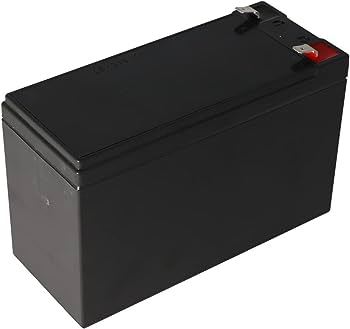
A) Market Overview:
Lead Acid Batteries are rechargeable batteries widely used in various applications such as automotive, renewable energy storage, and UPS systems. These batteries are known for their low cost, high energy density, and reliability. The market for lead acid batteries is witnessing significant growth due to the increasing demand for renewable energy storage solutions and the growing automotive industry.
B) Market Key Trends:
The key trend driving the growth of the global Lead Acid Battery market is the surge in demand for renewable energy storage solutions. With the increasing use of renewable energy sources such as solar and wind power, the need for efficient energy storage systems has also risen. Lead acid batteries offer a cost-effective solution for storing renewable energy. These batteries can store excess energy during low-demand periods and supply it during peak demand, thereby ensuring a stable power supply. For instance, Tesla's South Australia Powerpack Project, a massive energy storage facility, utilizes lead-acid batteries to store renewable energy generated from wind farms.
The global Lead Acid Battery Market Size is estimated to be valued at US$ 47.5 Bn in 2021 and is expected to exhibit a CAGR of 8.2% over the forecast period 2022-2030, as highlighted in a new report published by Coherent Market Insights.
C) PEST Analysis:
Political: The political landscape plays a crucial role in shaping the lead acid battery market. Government policies and regulations regarding the use of lead acid batteries in automotive and renewable energy sectors can impact the market growth.
Economic: Economic factors such as GDP growth, disposable income, and consumer spending patterns influence the demand for lead acid batteries.
Social: The growing awareness about the need for sustainable energy solutions and the increasing adoption of electric vehicles contribute to the demand for lead acid batteries.
Technological: Technological advancements in battery technology, such as improvements in efficiency, lifespan, and charging capabilities, drive innovation in the lead acid battery market.
D) Key Takeaways:
The global Lead Acid Battery market is expected to witness high growth, exhibiting a CAGR of 8.2% over the forecast period, due to the increasing demand for renewable energy storage solutions. Lead acid batteries provide an efficient and cost-effective solution for storing excess renewable energy.
In terms of regional analysis, Asia Pacific is the fastest-growing and dominating region in the lead acid battery market. The region is witnessing rapid industrialization and urbanization, leading to an increased demand for reliable power supply systems. Additionally, the automotive industry in countries like China and India is thriving, further driving the demand for lead-acid batteries.
Key players operating in the global Lead Acid Battery market include Johnson Controls, ATLASBX Co. Ltd., Exide Technologies, East Penn Manufacturing Co, Crown Battery Manufacturing Company, C&D Technologies INC., GS Yuasa Company, Leoch International Technology Ltd., Chaowei Power Holdings Limited, and Camel Group Co. Ltd., Hoppecke Batterien GmbH & Co. KG. These players are focusing on product innovations, partnerships, and acquisitions to strengthen their market presence.
In conclusion, the global Lead Acid Battery market is expected to witness significant growth in the coming years due to the increasing demand for renewable energy storage solutions. The market is driven by factors such as government initiatives for clean energy adoption and the growing automotive industry. Asia Pacific is anticipated to be the fastest-growing region in the market, with key players actively participating in product development and acquisitions to gain a competitive edge.
#Lead Acid Battery Market#Lead Acid Battery Market Size#Coherent Market Insights#Lead Acid Battery Market Demand#Lead Acid Battery Market Growth#Lead Acid Battery Market Analysis#Lead Acid Battery Market Trends#Lead Acid Battery Market Forecast
0 notes
Text
Lead Acid Battery Market Outlook On The Basis Of Product, Construction Method, Application, Region And Forecast From 2023 to 2030
San Francisco, 27 June 2023: The Report Lead Acid Battery Market Size, Share & Trends Analysis Report By Product (SLI, Stationary, Motive), By Construction Method (Flooded, VRLA), By Application, By Region, And Segment Forecasts, 2023 – 2030
The global lead acid battery market size is expected to reach USD 55.23 billion by 2030, according to a new report by Grand View Research, Inc. The market…
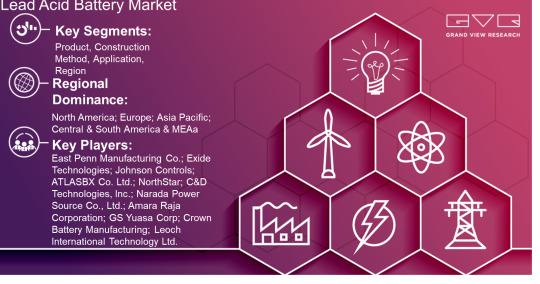
View On WordPress
#Lead Acid Battery Industry#Lead Acid Battery Market#Lead Acid Battery Market 2023#Lead Acid Battery Market 2030#Lead Acid Battery Market Revenue#Lead Acid Battery Market Share#Lead Acid Battery Market Size
0 notes
Link
#market research future#lead acid battery market#lead acid battery industry#lead acid battery#lead acid battery market size
0 notes
Link
#market research future#lead acid battery market#lead acid battery industry#lead acid battery#lead acid battery market size
0 notes
Text
The global advanced lead acid battery market revenue surpassed USD 25.91 billion in 2022 and is estimated to reach around USD 57.98 billion by 2032, growing at a healthy CAGR of 8.39% from 2023 to 2032.
0 notes
Text
#Global Lead Acid Battery for ESS Market Size#Share#Trends#Growth#Industry Analysis#Key Players#Revenue#Future Development & Forecast 2023-2032
0 notes
Text
Africa Lead Acid Battery Market Outlook: Key Growth Factors and Forecast
The global Africa Lead Acid Battery Market is estimated to attain a valuation of US$ 6.2 Bn Bn by the end of 2031, states a study by Transparency Market Research (TMR). Besides, the report notes that the market is prognosticated to expand at a CAGR of 4.1% during the forecast period, 2022-2031.
The key objective of the TMR report is to offer a complete assessment of the global market including major leading stakeholders of the Africa Lead Acid Battery industry. The current and historical status of the market together with forecasted market size and trends are demonstrated in the assessment in simple manner. In addition, the report delivers data on the volume, share, revenue, production, and sales in the market.Request for a Sample of this Research Report (Use Corporate Mail ID for Top Priority) - https://www.transparencymarketresearch.com/sample/sample.php?flag=S&rep_id=5870
#Lead Acid Battery Market#Lead Acid Battery#Lead Acid Battery Market Size#Lead Acid Battery Market Share#Lead Acid Battery Market Growth#Lead Acid Battery Market Analysis#Lead Acid Battery Market trends
0 notes
Text
#Global Automotive Lead Acid Battery Market Size#Industry Analysis By Segmentations#Top Key Players#Trends#Future Development & Forecast 2022-2030
0 notes
Text

The global automotive lead acid batteries market was valued at USD 34.30 billion in 2015 and is projected to reach USD 45.03 billion by 2021, at a CAGR of 4.8% from 2016 to 2021. The market is expected to witness growth in the coming years, owing to the increasing demand for SLI (start lighting and ignition) batteries from the OEM and replacement market of the automotive industry.
#Automotive Lead Acid Batteries Market#market trends#market size#market growth#market analysis#market forecast
0 notes
Text
Which electric scooter is the greatest one, do you know? Here are the top 10 electric scooters in India:
Due to the rising cost of fuel, electric scooters have become a viable alternative to petrol scooters. The best electric scooters on the market in India are listed below.
Electric scooters come in a wide range of sizes and designs in India. To help you in your quest, we've compiled a list of the best electric scooters currently on the market in India. E-scooters are included on the list from both established and new businesses. These scooters are not only cost-effective but also environmentally benign because their operating and maintenance costs are lower than those of their ICE counterparts. Additionally, many electric scooters, if not all, now match their fuel-powered equivalents, and you can further lower the cost with government incentives from the federal and state governments, subject to change. Here are the best 10 electric scooter in our opinion:
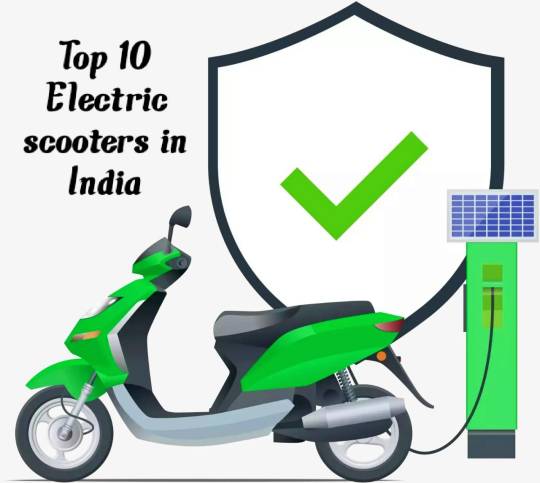
1)Hero Electric Optima CX (dual-battery):
Currently, Hero Electric continues to rank among the most well-known brands in the EV sector, which should not be confused with Hero Motocorp. One of the brand's most dependable workhorses is the Hero Electric Optima CX, and the Sohinder Singh Gill-led business is one of the most well-known producers of electric scooters on Indian roads. We highly recommend the dual-battery model of the scooter, which has a wonderful certified range of 140 km each charge cycle. Additionally, the battery is detachable, making it even more useful as you can charge it at home without necessarily having a mobile charging station. The scooter is the ideal option for city commuting because of its top speed of 45 kmphYou also receive comforts like a computerised instrument display and a USB port for charging your smartphone. See (https://heroelectric.in/bike/optima-cx-dual-battery/) for additional details.
Hero Electric Optima CX price in India: The EV is priced in India at Rs 77,490.
Benefits
Great riding range
Detachable battery for charging
Has all the essential features

2) Bajaj Chetak:
In the past, Bajaj Chetak was among the most well-known and well-liked scooter brands. The business is now bringing it back in an electric version. The scooter's design is a stunning fusion of its historical tradition and contemporary elegance. In terms of specifications, it has a range of up to 108 km, and the battery is expected to last 70,000 km, or 7 years. The battery features a rapid charging capability that allows for a 25 percent charge in only one hour and a full charge in just five. Its steel body is made to last and has an IP67 rating for water and dust resistance. It is without a doubt a high-end scooter, but the price is still too much. For more information (https://www.chetak.com/)
Bajaj Chetak EV price in India: The Bajaj Chetak starts at a price of Rs 1,21,000 (ex-showroom).
Benefits
Good durability
Charges fast
Iconic brand

3) TOYA:
The TOYA electric scooter, which is gorgeous and sporty-looking, was just released in the Indian market in 2021–2022. It is produced by West Burdwan's DEEDEV Motors. The TOYA is powered by a 48v/60v battery and has a top speed of 25 km/h. It is said to have an all-day range of 80 km in power mode. The most popular model is this one. The scooter comes with two riding modes: City and Eco. Batteries are created by combining lead acid with lithium ion. The battery can be charged for up to 3-4/6-8 hours. Other characteristics of this scooter include: 1-2-3 gear, reverse gear, alarm system, LED light, remote control, USB, auto pilot mode, among others. The customization of battery options, etc. For more information (https://deedavmotors.com/)
TOYA price in India: The Toya at a price of Rs 49,999.
Benefits
Reverse mode
Modern and flashy looks
Push foot rest
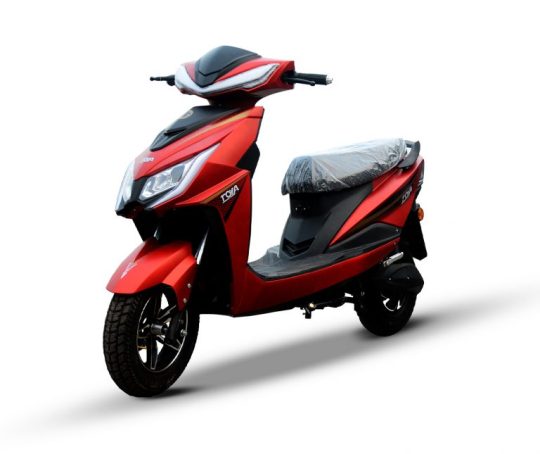
4) Simple One:
The Simple One is a new electric scooter that looks similar to the Ather 450X and Hero Vida V1 in that it is sleek and athletic. The official website of the business now offers Simple One for sale after various delays. The e-scooter's features and drivetrain include an 8.5kW motor with a maximum torque output of 72Nm. A 3.3kWh Lithium-ion battery powers the engine, and a fifth removable battery under the seat brings the overall capacity to 5kWh. The scooter's advertised range on a single charge is 212 km. A combi braking system, connectivity options, a 7-inch TFT display, LED lighting, alloy wheels, disc brakes, and many more useful features are also included. For more information (https://www.simpleenergy.in/)
Simple One price in India:
The Simple One’s standard variant can be purchased for Rs 1,45,000 (ex-showroom) while the top model is available for Rs 1,50,000 (ex-showroom) in India.
Benefits
Distinctive look and design
Good riding range
Great set of features

5) MIMI:
The MIMI, which is made by DEEDEV Motors, is one of the most reasonably priced electric scooters available today. The motor can propel the bike at up to 25 kph, though this speed can change based on which of the three riding modes you choose, Eco, City, or Sports. The battery's stated range is 80 kilometres, and it can take 3–4–6–8 hours to fully charge it using the charger. Other features include an alarm system, 1-2-3 gear, reverse gear, unique battery, LED headlamp, and more. Visit DEEDEV Motors for more information. (https://deedavmotors.com/)
MIMI price in India: The MMI at a price RS. 49,999.
Benefits
One of the most affordable e-scooty
Multiple riding modes
Best for girl’s
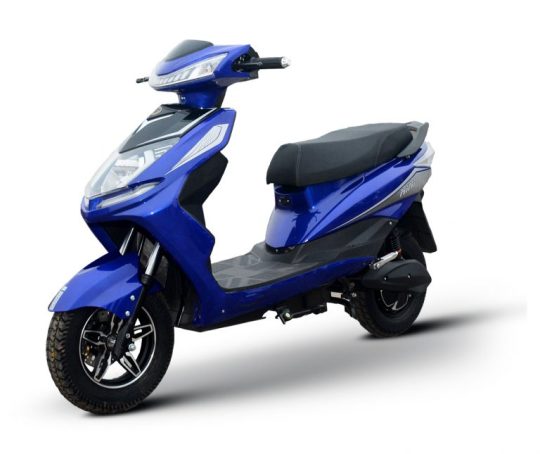
6) Hero Vida V1:
HereThe Vida V1 is the first electric scooter that Vida, a division of Motocorp, has produced. The scooter comes in two different models: Vida V1 Plus and Vida V1 Pro. Both versions have a top speed of 80 kmph, although the V1 Pro accelerates from 0 to 40 kmph in 3.2 seconds compared to the V1 Plus' 3.4 seconds. In accordance with the stated range, the new EV two-wheelers will be able to deliver a range of 163 km for the V1 Pro and 143 km for the V1 Plus, respectively. Both electric scooters are run by a portable battery pack that can be charged from empty to 80% capacity in about 65 minutes. Both Vida V1 models' 7-inch touch displays give users access to a variety of intelligent capabilities, including as trip statistics, riding simulators, parking help, and navigation. Visit(https://www.vidaworld.com) for additional information.
Hero Vida V1 price in India:
The Vida V1 Plus and V1 Pro come at an ex-showroom price of Rs 1,28,000 and Rs 1,39,000 respectively which includes the FAME II and state subsidy. Additionally, the reservation price is set at Rs 2,499.
Benefits
Portable battery for charging
All round robust design
Decent pickup times

7) TVS iQube ST:
The TVS iQube ST electric scooter sticks out for having a more traditional appearance, but that has advantages of its own. For starters, the iQube ST features one of the largest boot compartments, allowing you to fit two full-sized helmets to protect both you and your travelling companion. That's not all, though. The scooter has a maximum riding range of 110 km in performance mode and 145 km in economy mode. The scooter is one of the best-performing electric scooters on the market because it can reach a respectable riding speed of 82 kmph when used in the latter. Additionally, you get a 7-inch touchscreen with Bluetooth audio playback, Amazon Alexa voice assistant integration, and even social media notification screens that adhere to all safety precautions to keep you from being distracted. For more details (https://www.tvsmotor.com/iqube/tvs-iqube-st-variant-details)
TVS iQube ST price in India:
The TVS iQube ST comes with a sticker price of Rs 1,09,256 in Delhi.
Benefits
Excellent range
Rich set of features
Four body colours

8) Toper:
The Simple One is a brand-new electric scooter that boasts a sporty design much. It’s also manufactured by DEEDEV Motors. DEEDEV Motors company is one of the most well-known manufacturers of electric scooters. Simple One is now finally available to purchase through the company’s official website (https://deedavmotors.com/). The battery can take upto 3-4/6-8 hours to charge. Running under the hood is a 48v/60v Lithium-ion battery. The scooter is able to provide 80km of claimed range on a single charge. Apart from that, there are several handy features packed in as well such as a combi braking system, alarm system, LED lighting, alloy wheels (black), remote control, customise the battery choice, USB and many more.
Toper price in India: The Toper at a price RS. 49,999.
Benefits
Distinctive look and design
Good riding range
Great set of features
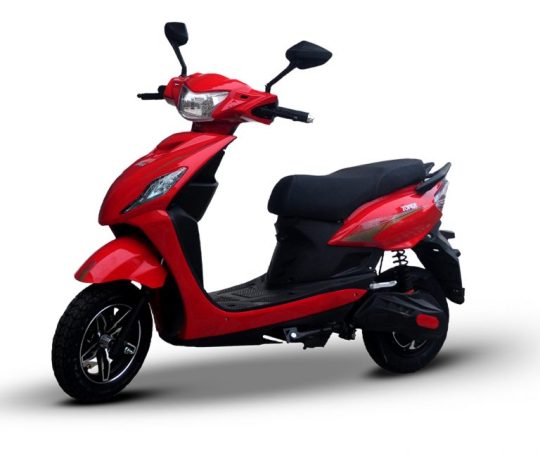
9) Bounce Infinity E1:
Even if you do not pay the full retail price, the Bounce Infinity E1 scooter is still available to you through the company's Battery-as-a-service, or BAAS, agreements at a much cheaper cost. The plans include a switchable battery option for Rs 35 each switch and a monthly membership charge that starts at Rs 849. The actual cost of the Bounce Infinity E1 is thus reduced to Rs 0.65 per kilometre.
The 85-kilometer maximum range and 65-kilometer top speed of the Bounce Infinity E1 are both on a single charge. Three different driving modes are offered: Drag, Eco, and Power. Aside from being IP 67 rated, adaptable, and portable, the 2kWhr 48V battery pack for the electric scooter is also available. For more information (https://bounceinfinity.com/infinity_e)
Bounce Infinity E1 price in India:
The Bounce Infinity E1 is retailing in India at Rs 68,999 (with battery) and Rs 36,099 (without battery).
Benefits
Cost
Swappable battery
Regenerative braking system

10) Okaya Fast F2F:
One of the most reasonably priced electric scooters on the market right now is the Okaya Fast F2F. The Fast F2F has an 800W BLDC hub motor that can reach high speeds of up to 55kmph. high speeds may also vary according on the riding modes, which include Eco, City, and Sports. The battery, which has an advertised range of 80 km, can take up to 5 hours to fully charge using the included charger. A remote key, digital instrument cluster, and LED headlamp are a few other highlights. For more information (https://okayaev.com/faast-f2f/)
Okaya Fast F2F price in India:
The Okaya Fast F2F is available at starting price of Rs 83,999 (ex-showroom) in India
Benefits
Very affordable compare to others
Multiple riding modes
Many features are available
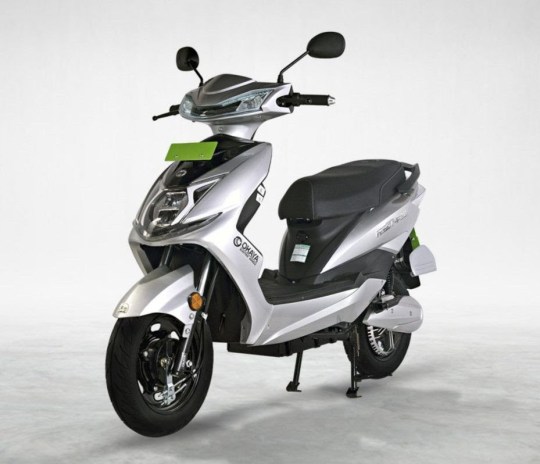
#electric vehicles#west bengal#scooter#electric scooter#top electric scooter in india#top electric scooter2023
4 notes
·
View notes
Text
What Is A Deep Cycle Battery? (A Closer Look 2023)

Most electric golf carts have deep-cycle batteries. It is, therefore, important for golf cart owners to understand the term deep-cycle battery so they can maintain their carts properly.
In any off-grid or renewable energy system, a deep-cycle battery is a crucial component. Long-term power storage applications often use these batteries. The purpose of this article is to explain deep-cycle batteries, their types, uses, and charging methods.
What Is A Deep Cycle Battery?
Battery deep cycle units are designed to be discharged to a greater extent, usually up to 50% or more of their capacity. These batteries provide continuous and reliable power.
A deep cycle battery’s depth of discharge (DOD)is important because it determines how much capacity is used during a single discharge. When a battery is fully discharged, its DOD is 100%. These deep-cycle batteries can easily handle the deep discharge of 80%-100%.
Monitoring the state of charge (SOC) of the battery is also important since it indicates its current capacity.
There are different types of deep-cycle batteries— each having its own advantages and disadvantages. Here are some common ones:
Flooded Lead-Acid
Gel and AGM
Lithium-Ion
Deep Cycle vs. Starting Battery
The purpose of starting batteries, also called cranking batteries, is to provide a quick burst of energy to start an engine. These batteries have many thin plates, which provide a high current for a short time. These batteries are not designed to be deeply discharged and then recharged. It can damage the battery and shorten its lifespan if you do so.
On the other hand, deep-cycle batteries are designed to be charged and discharged repeatedly. These batteries have thicker plates, enabling them to provide steady energy over a longer period of time.
One of the main differences between deep-cycle batteries and starting batteries is their construction. A starting battery is designed to deliver a large amount of current for a short period of time. In contrast, a deep-cycle battery provides a lower amount of current for a longer duration.
Another difference between deep-cycle batteries and starting batteries is their state of charge. The state of charge of starting batteries must always remain high, while deep cycle batteries can be discharged to a lower charge without deteriorating.
How To Tell If A Battery Is A Deep Cycle
The following ways can help you identify a deep-cycle battery:
Check the Label: Battery labels should indicate whether they are deep-cycle batteries. Look for terms like “deep cycle,” “marine,” or “recreational.”
Look at the Size: Deep cycle batteries tend to be larger and heavier than regular car batteries. Additionally, they have thicker inner plates that can withstand deep discharges.
Check the Amp-Hour Rating: The amp-hour rating indicates how much energy a battery can hold. Compared to regular car batteries, deep cycle batteries have a higher amp-hour rating.
Look for “Deep Cycle” Features: Deep cycle batteries usually have thick plates, reinforced posts, and special separators that improve performance.
Batteries labeled as “deep cycle” are not all the same. The capacity and lifespan of some batteries may be higher than those of others, so it is important to choose the right battery for your specific application.
Types Of Deep Cycle Battery

A wide range of deep-cycle batteries is available on the market, each with its own unique characteristics and advantages. The following are the most common types of deep-cycle batteries:
Flooded Lead Acid Batteries
The most common deep-cycle battery type is the flooded lead acid battery. While affordable and reliable, they need regular maintenance to perform at their best. These batteries have a liquid electrolyte that can spill when tipped or damaged.
Sealed Lead Acid Batteries
The sealed lead acid battery is similar to the flooded lead acid battery but without the need for regular maintenance. The batteries in this category are commonly used in emergency lighting systems and uninterruptible power supplies (UPS).
Gel Batteries
Unlike liquid batteries, gel batteries use a gel electrolyte instead of a liquid electrolyte. The batteries are maintenance-free and last longer than flooded lead-acid batteries. A gel battery is commonly used in renewable energy systems and marine applications.
Absorbed Glass Mat (AGM) Batteries
An AGM battery is also a sealed lead acid battery but uses a fiberglass mat to absorb the electrolyte. As a result, they are more resistant to vibration and shock than other types of batteries. AGM batteries are commonly found in RVs, boats, and backup power systems.
Lithium Ion Batteries
Lithium-ion batteries are modern deep-cycle battery that offers several advantages over traditional lead acid batteries. Battery life is longer, lightweight, and can be discharged deeper without damage. However, they are also more expensive and require special charging devices.
What Are Deep Cycle Batteries Used For
The deep-cycle battery is commonly used in applications that require a reliable and steady power source for a long time. The following are some common uses for deep-cycle batteries:
Solar and wind power systems
Golf carts and electric vehicles
Boats and marine applications
RVs and campers
Backup power systems for homes and businesses
Telecommunications and UPS systems
Deep Cycle Battery Lifespan
The lifespan of a deep cycle battery depends on several factors, including its type, depth of discharge, and charging method. Deep-cycle batteries can last between 4 and 10 years with proper maintenance and usage. Although lithium-ion batteries can last up to 15 years but are more expensive than lead-acid batteries.
How To Charge A Deep Cycle Battery
Charging a deep cycle battery correctly is essential to ensure its longevity and optimal performance. Different charging methods will be used depending on the battery type and charging system. Charge deep-cycle batteries using a charger that is specifically designed for them and follow the manufacturer’s instructions. Undercharging or overcharging a deep-cycle battery can significantly shorten its lifespan.
Choose the Right Charger: Select a charger specifically designed for deep-cycle batteries. Using a regular car battery charger can damage a deep-cycle battery.
Check the Voltage: Use a multimeter to test the battery’s voltage before charging. If the voltage is below 12 volts, you should use a trickle charger to slowly increase the voltage before using a regular charger.
Connect the Charger: Connect the charger according to the manufacturer’s instructions. Ensure you connect the positive (+) and negative (-) terminals correctly.
Set the Charge Rate: Select a charge rate that matches the battery’s specifications. To avoid damaging the battery, charge it at a slower rate.
Monitor the Charging Process: Monitor the charger while charging the battery. If the battery starts to get hot, stop the charging process and let the battery cool down before continuing.
Disconnect the Charger: Disconnect the charger once the battery is fully charged. It is important not to overcharge the battery since it can damage it and reduce its lifespan.
To properly charge a deep-cycle battery, follow the abovementioned steps. Failure to do so can damage the battery and reduced performance.
Conclusion
The deep cycle battery plays an important role in off-grid and renewable energy systems, boats, RVs, and other mobile devices. The various types of batteries are designed to provide a reliable and steady power source over an extended period, and each has its own advantages and disadvantages. Investing in the right deep-cycle battery for your application and charging it correctly will ensure optimal performance and longevity.
1 note
·
View note
Text
Next Generation Energy Storage Market - Forecast (2024 - 2030)
The Next Generation Energy Storage market size in 2021 is estimated to be $18.5 billion and is projected to reach $34.9 billion in 2027 at a CAGR of 9.18% during the forecast period 2022-2027. Energy storage is the pivotal technology that is reshaping the energy sector by enabling widespread deployment and grid integration of solar and wind renewables, to accommodate optimum levels of renewable energy. Therefore, to overcome intermittency and availability issues, various industrial sectors, such as Transportation, Oil and Gas, Mining, Electronics and others are adopting technological advances to improvise the economics of energy storage, which eventually propels the Next Generation Energy Storage Systems Market. Furthermore, research and innovation in energy storage is rapidly evolving due to the rise of decentralized and renewable energy solutions, emergence of energy conversion efficiency, cost effective technology, introduction of materials with low environmental and social impact and others are projected to foster the growth of the Next Generation Energy Storage Systems, dynamically.
👉 𝐃𝐨𝐰𝐧𝐥𝐨𝐚𝐝 𝐑𝐞𝐩𝐨𝐫𝐭 𝐒𝐚𝐦𝐩𝐥𝐞 @ https://tinyurl.com/2tythhew
Next Generation Energy Storage Market Report Coverage
The report: “Next Generation Energy Storage Market – Forecast (2022-2027)”, by IndustryARC covers an in-depth analysis of the following segments of the Next Generation Energy Storage industry.
By Device: Ultracapacitors, Energy Grids, Batteries, Fuel Cells, Flywheels, Pumped Storage and Others.
By Application: Electronics, Oil and Gas, Transportation, Military, Marine, Mining, Manufacturing, Residential and Others.
By Geography: North America (U.S, Canada, Mexico), South America (Brazil, Argentina and others), Europe (Germany, UK, France, Italy, Spain, Russia and Others), APAC (China, Japan India, SK, Aus and Others), and RoW (Middle east and Africa).
Key Takeaways
The Next generation energy storage systems refers to the integration of renewable energy generation into the grid, for relatively large loads across periods extending up to the extended hours. The deployment of the innovative devices, such as Energy grids, Ultracapacitors, Batteries, along with the automation tools, such as smart inverters, physical sensors and advanced analytics are coordinating across a wider range of next-generation technologies.
The rising grid expansion and promising investment in advanced infrastructure across Mining, Manufacturing, Oil and Gas, Electronics and other industrial sectors are estimated to drive the market. In addition, the introduction of regulations for green energy, and rising demand in the energy efficiency promote the Next generation energy storage systems market.
The prominence of renewable energy investments by the major companies, including Beckett Energy Systems, Lockheed Martin Corporation, BYD Company Limited, FlexGen Power Systems and more, along with increasing electrification of the transport sector are denoting profitable opportunities for the growth of Next generation energy storage systems market in the forecast period.
Next Generation Energy Storage Market Segment Analysis – By Type
The market for Next Generation Energy Grid Energy Storage Systems is analysed to grow at highest CAGR of 10.9% during the forecast period 2022-2027. There are growing research and development in terms of electricity storage for applications, such as Grid support, Electricity supply, Ancillary services, Renewables integration and more is considered as a prime success factor in increasing the market prominence of energy storage technologies. Presently, the lithium-ion and lead-acid batteries are becoming popular for residential users, and sodium-sulphur and other breakthrough batteries are majorly deployed in commercial sectors. The leading companies such as Beckett Energy Systems, BYD Company Limited, Energ2, Inc., Enersys, Enphase Energy, FlexGen Power Systems, Lockheed Martin Corporation, S&C Electric Company, UniEnergy Technologies, LLC. And AES Corporation played a significant role to accelerate the Next Generation Energy Storage Systems Market growth through extensive research and developments activities for product innovation
Next Generation Energy Storage Market Segment Analysis – By End Use Industry
The Transportation is estimated to be $ 4669.99 Million in 2021 and is analyzed to grow at a CAGR of 10.77% during forecast period 2022 to 2027. The Electric vehicles are the solution for this problem. However, there are many challenges like the less availability of charging stations. To overcome and fix these issues, what we need is efficient next generation energy storage system for electric vehicles which can store more energy and in efficient manner, thus longer running time of vehicles with one time charging. The serious growing issue of climate change needs adoption of sustainable Transportation system. Because the way the demand of vehicles on road is increasing, and with the expected growth rate of usage of vehicles, the peak oil demand could be reached very soon. With this they are ideal for use in short-distance electric vehicles such as taxis, trams and buses where the capacity to charge it is the time it takes for passengers to exit and enter a vehicle. Now virtually all automakers are offering plan to offer or are already offering fully electric vehicles or at least hybrid models.
Researchers from Imperial College London and University College London (UCL) are working towards creation of low-cost, high-energy supercapacitors which can power electric vehicles, and they have produced cheaper energy-dense electrode which is more sustainable and energy efficient and can make the way for wider market of high-power and rapid vehicle charging. In November 2019, Ford Unveiled its all Electric vehicle, which was part of company’s 11 Billion plan to make 40 all electric and hybrid models by 2022. Volkswagen as well has increased its electric vehicle goal to 70 new models by 2028 with the earlier target of 50. In April 2021, BYD announced the launch of the Electric vehicles, the BYD’s sedan HAN EV with the Blade Batteries. The first batch of Electric vehicles launched across Mexico, Brazil, Uruguay, Columbia, Costa Rica, the Dominican Republic and the Bahamas. The e6 is equipped with the Blade Battery abd comes with a range of 605 kilometers with 100km/h acceleration.
#Next Generation Energy Storage market price#Next Generation Energy Storage market size#Next Generation Energy Storage market share
0 notes
Text
Solar Vehicle Market: Ready To Fly on high Growth Trends

Market Research Forecast released a new market study on Global Solar Vehicle Market Research report which presents a complete assessment of the Market and contains a future trend, current growth factors, attentive opinions, facts, and industry validated market data. The research study provides estimates for Global Solar Vehicle Forecast till 2032.
The Solar Vehicle Market size was valued at USD 383.4 USD Million in 2023 and is projected to reach USD 1389.90 USD Million by 2032, exhibiting a CAGR of 20.2 % during the forecast period.
Key Players included in the Research Coverage of Solar Vehicle Market are:
Sono Motors GmbH (Germany), Lightyear (Netherlands), VENTURI (Monaco), Nissan (Japan), Mahindra & Mahindra Limited (India), Toyota Motor Corporation (Japan), Ford Motor Company (U.S.), Volkswagen AG (Germany), Daimler AG (Germany), Tesla, Inc (U.S.)
What's Trending in Market: Rising Adoption of Automation in Manufacturing to Drive Market Growth
Market Growth Drivers: Increasing Demand for Forged Products in Power, Agriculture, Aerospace, and Defense to Drive Industry Expansion
The Global Solar Vehicle Market segments and Market Data Break Down Vehicle Type: Passenger Vehicles and Commercial Vehicles","Battery Type: Lithium Ion, Lead Acid, and Others","Solar Panel: Monocrystalline and Polycrystalline
GET FREE SAMPLE PDF ON Solar Vehicle MARKET
To comprehend Global Solar Vehicle market dynamics in the world mainly, the worldwide Solar Vehicle market is analyzed across major global regions. MR Forecast also provides customized specific regional and country-level reports for the following areas.
• North America: United States, Canada, and Mexico.
• South & Central America: Argentina, Chile, Colombia and Brazil.
• Middle East & Africa: Saudi Arabia, United Arab Emirates, Israel, Turkey, Egypt and South Africa.
• Europe: United Kingdom, France, Italy, Germany, Spain, Belgium, Netherlands and Russia.
• Asia-Pacific: India, China, Japan, South Korea, Indonesia, Malaysia, Singapore, and Australia.
Extracts from Table of Contents
Solar Vehicle Market Research Report
Chapter 1 Solar Vehicle Market Overview
Chapter 2 Global Economic Impact on Industry
Chapter 3 Global Market Competition by Manufacturers
Chapter 4 Global Revenue (Value, Volume*) by Region
Chapter 5 Global Supplies (Production), Consumption, Export, Import by Regions
Chapter 6 Global Revenue (Value, Volume*), Price* Trend by Type
Chapter 7 Global Market Analysis by Application
………………….continued
More Reports:
https://marketresearchforecast.com/reports/car-rental-leasing-market-3007
For More Information Please Connect MR Forecast
Contact US:
Craig Francis (PR & Marketing Manager)
Market Research Forecast
Unit No. 429, Parsonage Road Edison, NJ
New Jersey USA – 08837
Phone: (+1 201 565 3262, +44 161 818 8166)
[email protected]
#Global Solar Vehicle Market#Solar Vehicle Market Demand#Solar Vehicle Market Trends#Solar Vehicle Market Analysis#Solar Vehicle Market Growth#Solar Vehicle Market Share#Solar Vehicle Market Forecast#Solar Vehicle Market Challenges
0 notes
Text
0 notes
Text
#Global Lead Acid Battery Market Size#Share#Trends#Growth#Industry Analysis#Key Players#Revenue#Future Development & Forecast 2023-2032
0 notes
Text
Silicon Anode Market: Powering the Future of Energy Storage
Introduction
Silicon anode is emerging as one of the most promising anode materials for the next generation of lithium-ion batteries due to its high theoretical capacity which is nearly 10 times greater than that of conventional graphite anodes. While silicon offers incredible storage potential, its use also presents significant engineering challenges as silicon undergoes a huge volume change of up to 300% during the charge-discharge cycles which can cause the anode to crack and crumble leading to rapid capacity fade. Researchers across the world are working on developing techniques to overcome this issue and make silicon anodes a commercial reality.
Nanostructured Silicon to Reduce Volume Change
A popular approach to deal with the volumetric expansions of silicon is to employ nanostructured forms of silicon such as silicon nanowires, nanoparticles or thin films which can better accommodate the large volume changes. Nanostructuring helps reduce mechanical stresses and improves cycle life by preventing cracking and pulverization. Many battery makers are experimenting with silicon nanostructures either alone or in composites with graphite and binders. For example, Enevate has developed silicon nanocoating technology where a thin layer of silicon is deposited onto metal current collectors using chemical vapor deposition process. This allows more than 80% capacity retention after 200 cycles with a 1000mAh/g silicon loading.
Design of Elastic Polymer Matrix
Another effective strategy is to suspend silicon nanoparticles within a porous, elastic polymer matrix such as polyacrylic acid, polyimide or carboxymethyl cellulose which acts as a ‘structural buffer’ and endures volume changes without breaking apart. The polymer matrix prevents cracking and offers flexibility for volume changes while maintaining good electronic contact between particles. Many startups like Amprius, OneD Materials and Sila Nanotechnologies are developing such silicon-polymer composite anodes for production. These anodes based on 25-50% silicon loading have shown high coulombic efficiencies above 99% for over 1500 cycles with capacities above 1000mAh/g.
Use of Silicon-Carbon Composite
Blending silicon with carbon is yet another approach gaining prominence. Companies like Lishen and Enovix are developing silicon-graphite-carbon composite anodes that leverage the advantages of both materials. Here, graphite provides the structural integrity while nano-silicon improves capacities. The carbon phase acts as a buffer against volume changes. Though capacities are lower than pure silicon, silicon-carbon composites offer higher cycle stability and are easier to commercialize. With 10-30% silicon content, capacities of 500-800mAh/g have been demonstrated along with over 2000 cycles of lifetime. They also reduce manufacturing complexities and costs.
Solid Electrolyte Interface for Stability
Stable formation of solid electrolyte interface (SEI) layer on the anode surface plays a crucial role in long cycle life. During charging, any fresh silicon surfaces exposed must quickly form a protective SEI layer to prevent further electrolyte decomposition. Researchers at Stanford University developed a method where a thin film of lithium phosphorus oxynitride is deposited on nanostructured silicon to stabilize SEI formation and achieve high coulombic efficiencies of over 99.8% for 500 cycles. Other approaches involve using electrolyte additives or surface coatings to engineer an optimized artificial SEI for improved kinetics and stability.
Progress towards Commercialization
Despite significant technical challenges, the huge promises of silicon anodes have ignited a wave of commercialization efforts. Enovix has demonstrated 3000+ cycles silicon anodes at large 1Ah size and is working with mobile phone manufacturers for product integration. Dash is aiming for electric vehicles and energy storage with an advanced nanocomposite anode claiming 3000 cycles at 80% capacity retention. Several silicon startups are now scaling production and bringing tons per month of cells to the market. Chinese battery giants like Lishen and EVE have also committed multi-million dollar silicon R&D programs. With continuous improvements, silicon dominated batteries could potentially power electric vehicles with 500-1000 km range on a single charge in the next 5-10 years, accelerating the transition to clean energy.
0 notes